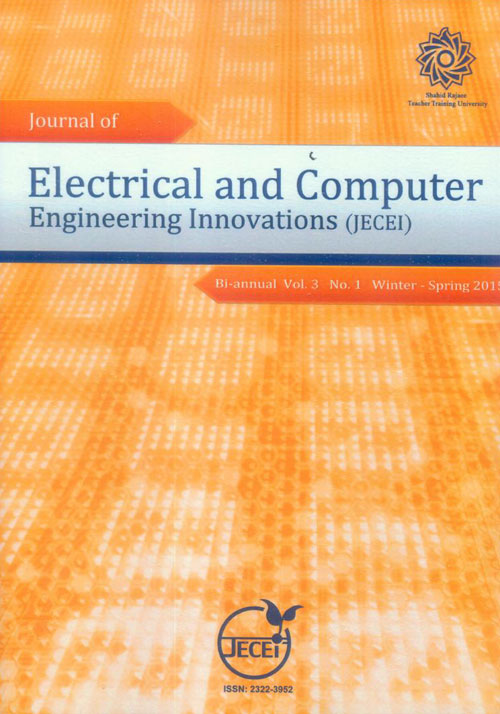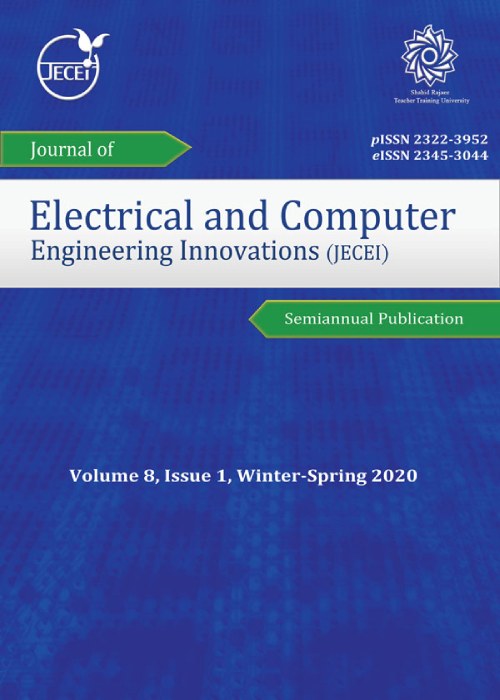فهرست مطالب

Journal of Electrical and Computer Engineering Innovations
Volume:3 Issue: 1, Winter - Spring 2015
- تاریخ انتشار: 1394/08/20
- تعداد عناوین: 6
-
-
Page 1Studying Gaussian beam is a method to investigate laser beam propagation and ABCD matrix is a fast and simple method to simulate Gaussian beam propagation in different mediums. Of the ABCD matrices studied so far, reflection and refraction matrices at various surfaces have attracted a lot of researches. However in previous work the incident beam and the principle axis of surface are in parallel. As an extension to those investigations, a general scheme that the incident beam is oblique is discussed here and the full analysis of the reflection and refraction of a Gaussian beam at the surface of a tilted concave/convex elliptic paraboloid surface is addressed. Based on the optical phase matching, analytic mathematical equations are derived for the spot size and the wavefront radius of a beam. Expressions are converted into the ABCD matrices, which are more convenient and practical to use. Finally, a practical case is analyzed by applying the obtained formulas. This analysis is important since paraboloid surfaces in optics or terahertz waves are used as mirrors or lenses.Keywords: Laser Beam, Gaussian Beam, ABCD Matrix, Reflection, Refraction, Tilted Surface, Convex, Concave Elliptic, Paraboloid Surface
-
Page 13In this paper, effects of the structural parameters on the optical characteristics of an add-drop filter, consisting of two straight waveguides and a micro-ring resonator (MRR), have been investigated. In this research, effects of MRR radius, the width of MRR and waveguide and the gap between MRR and waveguide, on free spectral range (FSR) and coupling coefficient have been studied. It is found thatby enhancing the gap and width, coupling coefficient would be increased at first but after a while it would be decreased. It is also shown that, increasing the radius and width would decrease FSR. The main goal of this research is to decrease FSR and increase the coupling coefficient of add-drop filters, which are widely used in communication applications.Keywords: Add, drop filter, Coupling coefficient, Free spectral range, Micro ring resonator
-
Page 17In this paper, we propose an optical millimetre wave radio-over-fibre (mm-wave RoF) system that uses a dual drive Mach Zehnder modulator (DD-MZM), which is biased at the maximum transmission biasing point, to generate an optical double sideband-suppressed carrier. The input to the DD-MZM are binary phase shift keying (BPSK), quadrature phase shift keying (QPSK), 8-phase shift keying (8-PSK) and 16-qaudrature amplitude modulation (16-QAM) schemes at a carrier frequency of 5 GHz with a rate of 2 Gsym/s and a local oscillator of 15 GHz obtain an mm-wave RoF signal at 30 GHz. We evaluate the generation and performances of the proposed system in terms of the power penalty, the error vector magnitude and the bit error rate (BER). Impairments including the self-phase modulation, chromatic dispersion and attenuation are considered when modelling the single mode fibre (SMF) based on the symmetrical split step Fourier method. We show that the power efficiency improves in the optimum region on average by ~11 dB, ~11 dB, ~12 dB and ~18 dB for BPSK, QPSK, 8-PSK and 16-QAM, respectively for the same optical launch power over 10, 30 and 50 km of SMF compared to the linear and non-linear regions.
-
Page 29In the restructured environment of electricity market, firstly the generating companies and the customers are looking for maximizing their profit and secondly independent system operator is looking for the stability of the power network and maximizing social welfare. In this paper, a one way auction in the electricity market for the generator companies is considered in both perfect and imperfect competition cases. A new model is provided to use the historical data of power market in the state of competition with imperfect information in which two probability functions were simultaneously used for the estimation of required information about each generator company. Nash equilibrium in the game theory is used to find the stability point in the biding strategy of generator companies. The effect of network conditions like limitation of transmission lines, network load, maximum generation of each generator company and the imperfect estimation of information about other competitors on the profit of generator companies and also on the market power of the generators in two mentioned competition methods were shown in the numerical simulation.Keywords: Power Market, Game theory, Bidding Strategy, Perfect Information, Imperfect Information
-
Page 37The destructive impact of fading environments and also bandwidth limitations are two main challenges which communication is dealing with them. These challenges can affect on the growth of wireless communication and even cause reliable communications and high data rate to be prevented. Thus, OFDM (Orthogonal Frequency Division Multiplexing) modulation by using of fast calculation hardwares such as FFT, high ability for combating multipath fading and appropriate spectral efficiency has taken into consideration. However, we should know that OFDM systems potentially have high Peak to Average Power Ratio (PAPR). This drawback drives the power amplifier into saturation leading to higher distortions and also degrades BER performance. Since increasing the dynamic range of power amplifier is not affordable, reduction of the PAPR is so important. In this paper, we investigate the PAPR and its reduction methods by using the theoretical and numerical analysis. These techniques can be classified into two main categories, signal distortion techniques, multiple signaling and probabilistic techniques. The advantages and disadvantages of each technique are derived from different prospectives. Moreover, we compare the numerical results of the techniques in the first classification from BER prospective which demonstrates that for changing the parameters corresponding to each technique, its performance can be changed greatly. Hence, we are sure that a technique can not outperform the other ones in all cases. Finally, the computational complexity of the techniques in the second classification are compared to each other which their results show that TR and TI techniques are much more complex than the other ones.Keywords: OFDM, PAPR, PAPR reduction methods
-
Page 47Uniform linear array (ULA)-based tapped-delay line (TDL) structure has good performance metrics when the signal sources are located at the middle angles. It offers poor performance when the signal sources are close to the array endfire. In this paper, a new approach is proposed which offers higher performance and desired beamforming on TDL structure when the wideband uncorrelated radio sources are close to the array endfire. This new TDL structure is based on Shirvani-Akbari array (SAA). Numerical results of this investigation show that both ULA-based and SAA-based TDL structures have the same performance where the signals of interest located at the middle angles. But, where the signals are close to the array endfire, the SAA-based TDL structure has much higher performance. In order to find a good comparison, the absolute array factor (AF) in center frequency for different angles and three well-known performance metrics, normalized mean square error (NMSE), signal to interference plus noise ratio (SINR) and bit error rate (BER) are evaluated for both ULA-based and SAA-based TDL structures.Keywords: Array endfire, Uniform linear array (ULA), Shirvani, Akbari array (SAA), Tapped, delay line (TDL)


